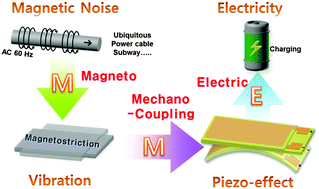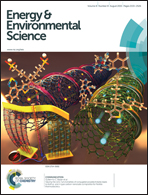Ubiquitous magneto-mechano-electric generator†
Abstract
Stray magnetic field considered as harmful noise for the human body can be a ubiquitous energy source. We are surrounded with 50/60 Hz parasitic magnetic noise arising from power delivery infrastructure, but it cannot be readily utilized by traditional electromagnetic harvesters. Here, we introduce a novel magneto-mechano-electric (MME) generator with a colossal power density that can turn on 35 LEDs and drive a wireless sensor network under a weak magnetic field of 5–7 × 10−4 T at a low frequency of 60 Hz. The MME generator is a cantilever structured magnetoelectric (ME) laminate composite in which the 〈011〉 oriented anisotropic single crystal fiber composite (SFC) is bonded to Ni plate and Nd permanent magnet proof mass. The ME laminate composite has a strong ME coupling (αME ∼ 160 V cm−1 Oe−1) even without magnetic bias due to the intrinsic property of Ni. The MME generator is also found to exhibit a colossal output power density of 46 mW cm−3 Oe−2 under a weak magnetic field of 1.6 × 10−4 T at 60 Hz. This MME generator can be a ubiquitous power source for wireless sensor networks, low power electric devices, and wireless charging systems by harvesting tiny amounts of parasitic magnetic energy from our living environment.


 Please wait while we load your content...
Please wait while we load your content...